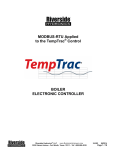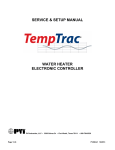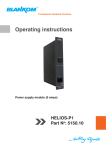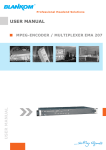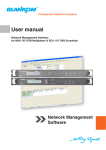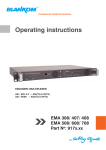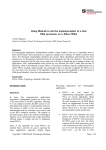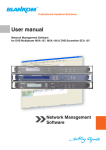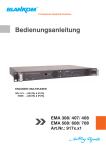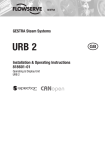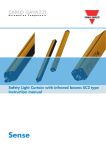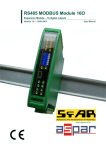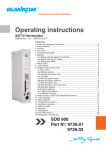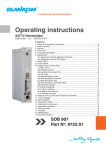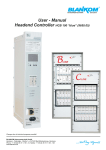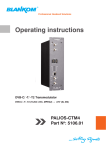Download USER MANUAL
Transcript
Professional Headend Solutions USER MANUAL USER MANUAL MPEG-ENCODER VEA 107 MPEG-ENCODER VEA 10x ( 917x.xx ) User manual Rev. 10 (2008) BLANKOM Antennentechnik GmbH/ Subject to modifications Content list 1. Basic installing and operating instructions____________________________________________ 2 1.1 Safety instructions ________________________________________________________ 2 1.2 Contact ________________________________________________________ 2 1.3 General description of functions ____________________________________________________ 3 1.4 “EASY Multiplexing” ________________________________________________________ 3 2. Explanation of the functional elements _______________________________________________ 4 2.1 Front view ________________________________________________________ 4 2.2 Rear view ________________________________________________________ 4 2.3 Audio input socket allocation (8 poles, DIN 45326) _____________________________________ 5 3. Operating instructions ________________________________________________________ 6 3.1 Assembly and commissioning _____________________________________________________ 6 3.2 Operation using factory settings (no further configuration) ________________________________ 6 3.3 Configuration via the Ethernet interface ______________________________________________ 7 3.3.1 Connecting the network to the computer __________________________________________ 7 3.3.2 Service and setup ________________________________________________________ 8 3.3.3 Default configuration ________________________________________________________ 9 3.3.4 Detailed configuration _______________________________________________________ 10 3.3.4.1 The single device system (one Master)_______________________________________ 10 3.3.4.2 Multi-device systems (cascades)____________________________________________ 12 3.3.4.2.1 The double device system (one Master, one Slave) __________________________ 13 3.3.4.2.2 The triple device system (one Master, two Slaves)___________________________ 15 3.3.4.2.3 4- or 5-device systems (one Master, up to four Slaves) _______________________ 17 3.4 Extended configuration, individual settings___________________________________________ 18 3.4.1. Exclusive coding of audio signals ______________________________________________ 18 3.4.2 TTX processing, VPS-WSS ___________________________________________________ 19 3.4.3 Transport Stream bitrate (TS out bitrate), system bitrate _____________________________ 19 3.4.4 Firmware updates _______________________________________________________ 21 3.4.5 Factory settings _______________________________________________________ 22 3.4.5.1 Setting by using the accompanying operator software ___________________________ 22 3.4.5.2 Setting by using the “Factory Set” key________________________________________ 22 3.4.5.3 Setting by using the maintenance software____________________________________ 22 3.4.6 Integration into the headend management system for B-LINE or C-LINE ________________ 23 3.5 Options, updates/upgrades ______________________________________________________ 24 3.5.1 RDS data transfer _______________________________________________________ 24 3.5.2 SDI signal interface _______________________________________________________ 24 3.5.3 Signal encoding _______________________________________________________ 25 3.5.4 Data transmission (customised)________________________________________________ 25 4. Appendix _______________________________________________________ 26 4.1 Technical data _______________________________________________________ 26 4.2 Versions, options _______________________________________________________ 27 4.3 Block diagrams _______________________________________________________ 28 4.3.1 Basic VEA 107/108 version (analogue A/V + VBI processor) _________________________ 28 4.3.2 Optional versions, VEA 107 and VEA 108 ________________________________________ 29 4.4 Accessories _______________________________________________________ 31 4.4.1 Accessories as standard _____________________________________________________ 31 4.4.2 Optional accessories _______________________________________________________ 31 4.4.2.1 Cables ______________________________________________________ 31 4.4.2.2 Plug-in connectors_______________________________________________________ 32 4.5 Glossary and abbreviations ______________________________________________________ 32 MPEG-ENCODER VEA 10x (917x.xx ) Manual Updated 10 (2008) BLANKOM Antennentechnik GmbH, Germany /Subject to modifications 1. Basic installing and operating instructions 1.1 Safety instructions - When assembling and commissioning the VEA MPEG2 Encoders and executing the settings, always follow the accompanying instructions exactly. - The devices are not to be assembled and brought into use by anybody who is not an authorised technician. - When components are being installed into headends, ensure that EMC regulations are observed. - All assembly, installation and cable connection must take place with cold state of the device. - The provisions of DIN EN 50083 must be observed at all times when working with the equipment. In particular, DIN EN 50083/1 regarding safety may on no account be ignored. - The devices come under protection classification I. It is absolutely necessary, therefore, to insert the mains plug into a socket with protective contact. Note: Connecting external video sources of which the mass has a different potential from that of the VEA107 or VEA108 may cause “hum” (avoided by matching the potentials or isolating them from each other). 1.2 Contact If there are any questions or problems, help is available from BLANKOM Antennentechnik GmbH Hermann-Petersilge-Str. 1 07422 Bad Blankenburg Germany Telephone: +49 (0) 3 67 41 / 60-0 Fax: +49 (0) 3 67 41 / 60-100 Email: Web: [email protected] www.blankom.de 2 MPEG-ENCODER VEA 10x (917x.xx ) Manual Updated 10 (2008) BLANKOM Antennentechnik GmbH, Germany/Subject to modifications 1.3 General description of functions The MPEG2 Encoders VEA 107/108 are components of the A-LINE headend system. Depending on the device and version (see Section 4.2), they serve to encode up to 3 analogue or uncompressed digital audio and/or visual signals, integrating them into the DVB Transport Stream. Analogue video and audio signals are fed into the system via the respective analogue input ports (video and audio); for “audio-embedded” digital A/V signals, the devices can be equipped with serial digital interfaces (SDIs). The output signal is a DVB Transport Stream as per ISO13818-1 and is transmitted from an ASI interface. ASI stands for Asynchronous Serial Interface. This signal can be fed into the cable TV network with the aid of a QAM modulator. The devices, being MPEG2 encoders with a five-fold “cascade” facility, are effectively Transport Stream Multiplexers, producing “bouquets” of up to 15 programmes. These, again, are broadcast via the ASI and can be further processed in the same way as described above. There are suitable QAM modulators available, for instance in BLANKOM’s A-LINE headend system. To choose the required type and to find out how to deal with these additional components, please refer to the product catalogue and the relevant description. Notes: The ASI input ports may only be used for Transport Streams from the VEA 107 or VEA 108 encoders. It is not possible to incorporate ASI signals from other systems into the Transport Stream. The output signal contains all the tables necessary to the programme and associated services (PAT, PMT and SDT). An NIT will be generated but will not contain any network-specific information. A succeeding QAM modulator is responsible for the necessary adaptation of the NIT. There are options permitting RDS data transfer via additional channel-specific access ports and enabling additional customer-specific details to be included via the Ethernet interface (see Section 3.5). 1.4 “EASY Multiplexing” “EASY Multiplexing” is a simple, uncomplicated means of producing a digital ASI Transport Stream. Depending on which device is in use, up to 3 analogue (A/V) signals or up to 3 digital (SDI) signals can be combined simply by one VEA 107 or VEA 108 into a single standard DVB signal, by means of “Plug and Play”. The parameters necessary have been set in the device at the factory (see Section 3.2). See Section 3.3.4.2 for details of how VEA 107 or VEA 108 cascade systems using multiple devices are brought into use and how the Transport Stream can be manipulated from the HTML user interface. 3 MPEG-ENCODER VEA 10x ( 917x.xx ) Manual Updated 10 (2008) BLANKOM Antennentechnik GmbH, Germany/Subject to modifications 2. Explanation of the functional elements 2.1 Front view Fig. 1: Front view, VEA 107 or VEA 108 LED display POWER INPUT VIDEO A, B, C LED not illuminated: INPUT TS (Master Mode) INPUT TS (Slave Mode) Operating voltage displayed LED illuminated: video signal recognised no video signal or video signal does not match standard LED not illuminated LED illuminated: ASI-TS signal at input port LED flashing: no ASI-TS signal at input port 2.2 Rear view Fig. 2: Rear view of VEA 107 or VEA 108 (with RDS option) Input and output ports VIDEO IN (A, B, C) AUDIO IN (A, B, C) ASI IN ASI OUT NET RS232 RDS IN (A, B, C) Video input ports Audio input ports Input port for Transport Stream (activated only if device working as Slave) Transport Stream output port Ethernet interface (network connection point for updating firmware, device control) RS232 interface (firmware update, factory settings) Input ports for RDS signals of channels A, B and C (optional) Sunk key FACTORY SET Resets all settings to factory settings 4 MPEG-ENCODER VEA 10x (917x.xx ) Manual Updated 10 (2008) BLANKOM Antennentechnik GmbH, Germany/Subject to modifications 2.3 Audio input socket allocation (8 poles, DIN 45326) 1 Stereo left+ or dual A+ or mono+ 2 Shielding (mass) 3 Stereo right+ or dual B+ 4 Stereo left- or dual A- or mono5 Stereo right- or dual B6 not used 7 not used 8 not used Fig. 3: Pole allocation, audio socket 5 MPEG-ENCODER VEA 10x ( 917x.xx ) Manual Updated 10 (2008) BLANKOM Antennentechnik GmbH, Germany/Subject to modifications 3. Operating instructions 3.1 Assembly and commissioning NB All assembly and connection must take place when no electricity has been connected. On no account may the safety notes (see Section 1.1) be ignored. The device is intended to be installed on sliding rails in a 19-inch rack. It is secured from the front with the assembly set supplied. One height unit must be allowed between devices for the avoidance of overheating. This may be disguised with a louvered ventilation plate if desired. Contact must be made for the video, audio and ASI signals at the A, B and C connection points on the rear of the device using appropriate cables. Those listed in Section 4.4.2 are recommended. From the ASI output port, the signal is sent either straight to the QAM modulator or to the succeeding Slave. As soon as all the wiring has been done for the signal, the mains cable can be connected and the device switched on. The operating status is shown by the LEDs on the front panel (see Section 2.1). 3.2 Operation using factory settings (no further configuration) The VEA 107 or VEA 108 is delivered with optimal configuration as Master for 3 AV channels. It will be functional with these settings without any further configuration. It is possible to get back the factory settings at any time by using the sunk “Factory Setting” key (see Section 3.4.5). All information on programmes and Transport Stream is neutral but can be adapted as necessary to match the requirements of a cable network operator. To do this, it is necessary to call up the HTML user interface via the Ethernet interface (see Section 3.3). 6 MPEG-ENCODER VEA 10x (917x.xx ) Manual Updated 10 (2008) BLANKOM Antennentechnik GmbH, Germany/Subject to modifications The factory settings for the VEA 107 are summarised in the table which follows. Parameters Value Notes TS- ID (PAT, SDT, NIT) Master / Slave Provider name Programme name ***** Master Provider Prog - A Prog - B Prog - C Dummy deu 36 3 (+ Data) 5-digit serial number Create NIT: (Master only) Programme language Mbps TS out bitrate Used input channels (number of AV channels) Video system PAL System bitrate Audio bitrate Audio mode TTX processing 8 Mbps 192 kbps Stereo Video IN VPS-WSS VPS Total bitrate for TS (ASI-OUT) To permit additional data (teletext etc.) to be transmitted, a data channel is always allocated in the Master. All programmes and the data channel have an equal share in the overall bitrate. The maximum system bitrate per channel is thus 36 / (n+1) A choice can be made between PAL and NTSC for each channel. 3 x A/V channels and 1 x data channel The teletext information, contained in the video signals for lines 7 to 15 and 19 to 22, also 320 to 328 and 332 to 335, will be digitized and then included in the DVB Transport Stream. VPS transmission and WSS active Table 1: factory settings 3.3 Configuration via the Ethernet interface If it is necessary to change the default configuration or to create a cascade of more than one VEA 107 or VEA 108 to create a shared data stream (see Section 3.3.4.2), the HTML user interface must be called up on a computer connected to the device(s). How the user interface works is almost self-explanatory. Any special features of use will be explained in the following chapters. 3.3.1 Connecting the network to the computer System requirements: - PC or laptop with 10/100 Mbit Ethernet interface - Internet browser (such as Windows Internet Explorer) Making the connections: The VEA 107 or VEA 108 must be connected to the PC network using an Ethernet cable. If connected directly to a PC, the Ethernet cable must be a cross-linked cable. The IP address of the VEA 107 or VEA 108 on delivery is 192.168.2.86. The address of the network connection in the PC must be adapted to accommodate the IP address of the VEA 107/108 (subnet mask: 255.255.255.0 / IP address: 192.168.1.XXX). 7 MPEG-ENCODER VEA 10x ( 917x.xx ) Manual Updated 10 (2008) BLANKOM Antennentechnik GmbH, Germany/Subject to modifications Do not let XXX be exactly the same as the IP address of the VEA 107 or VEA 108. When systems which are made up of more than one device as a cascade system are initially configured, it is necessary to ensure that VEA 107 or VEA 108 transcoders are connected to the network one after the other and configured separately, as the IP addresses of such transcoders on delivery are all the same. The IP address of the VEA 107 or VEA 108 is entered on the browser screen. When the link up has been successfully made, the device produces a pop-up log-in window: Fig. 4: Log-in window Access to the configuration menu is password protected. When the device is supplied, the password is “neu” (the German word for “new”). It is also necessary to enter the 5-figure serial number of the device being connected to the computer. This number is on the rear of the device. There are more labels showing the serial number contained in the scope of delivery; if desired, they can be placed somewhere else for easier identification, for instance on the front of the device. Note: If password or IP address are unknown or have been forgotten, the factory settings can be re-established by pushing in the (recessed) “Factory Set” key (see also Section 3.4.5, Factory settings). Afterwards the device is back in its state as delivered, with the access data and factory settings described above. The configuration menu appears once log-in has been accomplished. It is divided into three: - Service and setup - Default configuration - Detailed configuration The following sections describe the functions under each heading. 3.3.2 Service and setup This area is configured by clicking soft-keys as appropriate to select the desired function (see Figure 5). The following actions are possible: - Password change - Factory setting - Hilfe / Help - Download MIB - Set Date & Time Changing the password for the device Resets all settings to factory settings Calls up the help pages in German or English Downloads the MIB file specific to the device (ME.mib) to serve the system via SNMP Sets the clock within the device 8 MPEG-ENCODER VEA 10x (917x.xx ) Manual Updated 10 (2008) BLANKOM Antennentechnik GmbH, Germany/Subject to modifications Fig. 5: Setup and service menu 3.3.3 Default configuration The preselection window shown in Figure 6 makes it simple to adopt automatic pre-settings of the best possible parameters for starting up a single, double or triple device system. 1 Device Single device system with 3 programmes 2 Devices Double device system with 6 programmes 3 Devices Triple device system with 9 programmes Fig. 6: Menu for default configuration (factory settings) This is where the mode of operation in the cascade of each individual VEA 107 or VEA 108 is entered (as Master, Slave, Slave1 or Slave2). (In special cases, it is possible to cascade a maximum of 5 devices, see Section 3.3.4.2.3.) The total Transport Stream is thereby shared across the individual programmes and the data channel. At the same time, automatic programme names of a neutral nature are allocated, as are audio/video PIDs and service IDs in ascending order (see Tables 2 and 3). Configuration Input Master A B C Prog - A Prog - B Prog - C 0x11 + offset 0x12 + offset 0x13 + offset 0x111 0x112 0x113 0x211 0x212 0x213 0x311 0x312 0x313 0x411 0x412 0x413 RDS (piped mode) 0x319 0x31A 0x31B Slave1 D E F Prog-D Prog-E Prog-F 0x21 + offset 0x22+ offset 0x23 + offset 0x121 0x122 0x123 0x221 0x222 0x223 0x321 0x322 0x323 0x421 0x422 0x423 0x321 0x32A 0x32B Slave2 G H I Prog-G Prog-H Prog-I 0x31 + offset 0x32 + offset 0x33 + offset 0x131 0x132 0x133 0x231 0x232 0x233 0x331 0x332 0x333 0x431 0x432 0x433 0x331 0x33A 0x33B Slave3 J K L Prog-J Prog-K Prog-L 0x41 + offset 0x42 + offset 0x43+ offset 0x141 0x142 0x143 0x241 0x242 0x243 0x341 0x342 0x343 0x441 0x442 0x443 0x341 0x34A 0x34B M Prog-M 0x51 + offset 0x151 N Prog-N 0x52+ offset 0x152 O Prog-O 0x53 + offset 0x153 Table 2: Automatically allocated service IDs and PIDs 0x251 0x252 0x253 0x351 0x352 0x353 0x451 0x452 0x453 0x351 0x35A 0x35B Slave4 Programme Service Name PMT Video Audio TTX 9 MPEG-ENCODER VEA 10x ( 917x.xx ) Manual Updated 10 (2008) BLANKOM Antennentechnik GmbH, Germany/Subject to modifications To get unique service IDs if there are several cascades in one headend, an offset is automatically added for the parameter “cascade number within network” (CNr): 1 2 3 4 Cascade no. 0 0x04 0x08 0x0C Offset Table 3: Offset addition for the respective cascade numbers 5 0x80 6 0x84 7 0x88 8 0x8C 3.3.4 Detailed configuration The detailed configuration enables DVB identification characters and parameters such as provider name, network ID, program name, transmission parameters etc to be individually set. The user interface enabling detailed configuration is basically the same in all BLANKOM devices whatever the system. Note: Whenever individual settings are made, care should be taken to ensure that the figures entered into the configuration mask make sense technically and/or count as valid figures. 3.3.4.1 The single device system (one Master) This is the configuration which is basically the factory settings on delivery. It can also be selected in the “1 Device” window of the menu of the default configuration (see Fig. 6). Possible detailed configuration options are: IP address, IP subnet mask TS-ID Provider name Network ID Programme names (necessary if the device is being integrated into an existing network) (the 5-figure serial number is entered as default) (the default entry is “Provider”) (the default entry is “100”) (entered at first as “Prog-A”, “Prog-B” and “Prog-C”) Figures 7-1 and 7-2 show all the possible setting options. The default is 3 channels with standard figures for the system bitrate. If these preset bitrates are being changed, account should be taken of the TS out bitrate which has been set and the number of channels to be transmitted, plus data channel and whether the new bitrates are compatible with these conditions (see Section 3.4.3). 10 MPEG-ENCODER VEA 10x (917x.xx ) Manual Updated 10 (2008) BLANKOM Antennentechnik GmbH, Germany/Subject to modifications Example: “Master” in a “1 Device” configuration IP-Address The network address is set to 192.168.2.86 in state as delivered and when “Factory setting” is pressed. The IP address can be altered in this menu. If there is no DHCP service available, the pre-set address is used. TS-ID (Transport Stream ID) The Transport Stream identification is allocated individually. It may appear only once in the cable network. The 5-figure serial number is entered as default. Create NIT The Master device can create the framework for an NIT (Network Information Table) if required. The options are: off - no NIT will be created, dummy – an empty NIT frame will be created, Satellite / Cable / Terrestrial – an NIT frame with the details appropriate to the TV format will be created. Network ID This must be exactly the same for all DVB channels within a cable network. Cascade Number within Network Each cascade of devices (max. 8) is given a separate address between 1 and 8 so that the PID is individualised (see Section 3.3.3) Fig. 7-1: Menu, detailed configuration Data PID enabled This is a device option allowing customised data to be inserted into the TS (see Section 3.5.4). 11 MPEG-ENCODER VEA 10x ( 917x.xx ) Manual Updated 10 (2008) BLANKOM Antennentechnik GmbH, Germany/Subject to modifications Video System / (Radio) This is for selecting the video standard (PAL, NTSC...) for the incoming signal. If the setting is “OFF”, only radio signals will be encoded (MPEG radio). System Bitrate The System bitrate is the bitrate (bandwidth) of a channel. It depends on the TS out bitrate and the number of channels within Transport Stream (see Section 3.4.3). Audio Mode For setting the sound mode: stereo, joint stereo, mono, dual channel, Use VPS. If use VPS is set, the relevant broadcaster details in the VPS line will be adopted into the DVB signal. TTX processing and VPS-WSS Options (see Section 3.4.2). Fig. 7-2: Menu, detailed configuration 3.3.4.2 Multi-device systems (cascades) Because the VEA 107 or VEA 108 is a device which can be cascaded, multi-device systems can be created. If this is done, changes need to be made to the set parameters from the HTML pages. Also, signal connections must be made (ASI-OUT/IN) between the devices using 75-ohm BNC cables (see Figure 8). 12 MPEG-ENCODER VEA 10x (917x.xx ) Manual Updated 10 (2008) BLANKOM Antennentechnik GmbH, Germany/Subject to modifications Fig. 8: Circuit diagram of a 3-device cascade 3.3.4.2.1 The double device system (one Master, one Slave) From the double device system upwards, each device must be individually configured. Ethernet connections are established separately, starting with the Master (see Section 3.3.1). For each device in the cascade, Master and Slave are designated under “2 Devices” in the menu of the default configuration by making the appropriate selection. Optimal bitrates for 6 programmes, also neutral programme names, are automatically assigned (see Section 3.3.3 and Fig. 6). If a device is being configured as a Slave, the ASI data stream input port is activated in addition. Once the default configuration has taken place for the 2-device system, there will be a system bitrate available to each channel of 4.92 Mbps. The detailed configuration is as in the single device system, with a few special features to note. All devices in a cascade must be given the same TS ID so that they can create a shared Transport Stream. The TS ID can be any number between 1 and 65535. However, at the start the TS ID will be the 5-digit serial number of the VEA 107 being initialised. In the simplest case, the TS ID of the Master should also be entered for the Slaves. In cable networks with more than one DVB channel, each TS ID is allowed to appear only once, which means that the TS IDs of the Transport Stream(s) generated by the (single or cascaded) VEA 107/108 device(s) must all be different and must be different from those of the Transport Streams from other broadcasters. To avoid duplication it is therefore necessary for the TS IDs which are already allocated in the cable network to be known before further Transport Streams are added. 13 MPEG-ENCODER VEA 10x ( 917x.xx ) Manual Updated 10 (2008) BLANKOM Antennentechnik GmbH, Germany/Subject to modifications Example: “Master” in a “2 Device” configuration TS-ID (Transport Stream ID) In 2- to 5-device systems the TS ID for all the devices (Master, Slave 1 and so on to Slave 4) must be exactly the same. But it may appear only once in the cable network. Create NIT (Master only) The decision as to generating NIT data must be made for the Master and will affect the whole cascade. Network ID The network ID must be exactly the same for all DVB channels within a cable network. Fig. 9: Detailed configuration of Master (“Channel MUX” menu) 14 MPEG-ENCODER VEA 10x (917x.xx ) Manual Updated 10 (2008) BLANKOM Antennentechnik GmbH, Germany/Subject to modifications Example: “Slave” in a “2 Device” configuration 6 AV programmes are integrated when the default configuration “Slave” is set here. The 3 programmes produced by the Slave will be given the programme names “Prog-D” to “Prog-F”. Individual programme names can be entered here. Fig. 10: Detailed configuration of Slave 3.3.4.2.2 The triple device system (one Master, two Slaves) In the case of a triple device system, all three devices must be individually configured. The procedure is as for the configuration of the double device system (see Section 3.3.4.2.1). First, the Ethernet connections are, again, established separately, starting with the Master (see Section 3.3.1). For each device in the cascade, Master and Slave are designated under “3 Devices” in the menu of the default configuration by making the appropriate selection. Optimal bitrates for 9 programmes, also neutral programme names, are automatically assigned (see Section 3.3.3 and Fig. 6). If a device is being configured as a Slave, the ASI data stream input port is activated in addition. Once the basic configuration has taken place for the 3-device system, there will be a system bitrate available to each channel of 3.52 Mbps. All devices in a cascade must be given the same TS ID so that they can create a shared Transport Stream. The TS ID can be any number between 1 and 65535. However, at the start the TS ID will be the 5-digit serial number of the VEA 107/108 being initialised. In the simplest case, the TS ID of the Master should also be entered for the Slaves. 15 MPEG-ENCODER VEA 10x ( 917x.xx ) Manual Updated 10 (2008) BLANKOM Antennentechnik GmbH, Germany/Subject to modifications Note: In cable networks with more than one DVB channel, each TS ID is allowed to appear only once, which means that the TS IDs of the Transport Stream(s) generated by the (single or cascaded) VEA 107/108 device(s) must all be different and must be different from those of the Transport Streams from other broadcasters. To avoid duplication it is therefore necessary for the TS IDs which are already allocated in the cable network to be known before further Transport Streams are added. Example: “Slave 2” in a “3 Device” configuration 9 AV programmes are integrated when the default configuration “Slave 2” is set here. The 3 programmes produced by the Slave 2 will be given the programme names “Prog-G” to “Prog-I”. Individual programme names can be entered here. Fig. 11: Detailed configuration of Slave 2 16 MPEG-ENCODER VEA 10x (917x.xx ) Manual Updated 10 (2008) BLANKOM Antennentechnik GmbH, Germany/Subject to modifications 3.3.4.2.3 4- or 5-device systems (one Master, up to four Slaves) For special situations, it is possible to combine up to 5 devices into a cascaded system. In principle, this type of configuration will enable a Transport Stream to be created carrying a maximum of 15 AV channels and a data channel. However, as the channels are equidistant from one another, there will only be 2.25 Mbps of bandwidth available per channel if the Transport Stream rate is 36 Mbps. If the maximum Transport Stream rate can be used (43.2 Mbps) a bandwidth of 2.7 Mbps could be achieved per channel. It must be said that the remaining bandwidth is only of limited suitability for the transmission of video signals, so that these types of configuration are not really recommended for that purpose. However, one special situation would be the digitalisation of radio programmes. The relevant configuration is available without limit. For this task, too, as for the multi-device systems described above, all the devices involved must be optimised individually. Again, Ethernet connections are established separately, starting with the Master (see Section 3.3.1). Below is an example of the settings for the individual devices. Example: Converting and combining 15 radio programmes into one DVB Transport Stream TS-ID (Transport Stream ID) The Transport Stream identification is allocated individually. It may appear only once in the cable network. All devices in a cascaded system must use the same TS ID. Master / Slave To be selected according to the position of the device. (Mbps) TS out bitrate 16.6 Mbps – 43.2 Mbps 1) Used Input Channels (1…9[15]) Maximum number of channels: 15 (in a 5-device system) Fig. 12: Channel MUX menu (15 radio programmes) Create NIT (Master only) The decision as to generating NIT data can only be made for the Master. Network ID The network ID must be exactly the same for all DVB channels within a cable network. 1) This setting can be any between 16.6 Mbps and 43.2 Mbps. For 15 programme channels and one data channel it is necessary to have 16x1024 kbps = 16.38 Mbps (cf. Section 3.4.3). Bandwidth not required is filled with dummy traffic. Further channel-specific settings must be made in the “1st, 2nd und 3rd Encoder” menus for the individual devices. 17 MPEG-ENCODER VEA 10x ( 917x.xx ) Manual Updated 10 (2008) BLANKOM Antennentechnik GmbH, Germany/Subject to modifications Programme Name Individual programme names can be entered. The presettings are Prog-A …Prog-O. Video System / (Radio) “Off”: Only audio data will be encoded. System Bitrate [1024…15000 Kbps] “1024” : this minimum data rate is adequate to audio transmission Fig. 13: Encoder menu (15 radio programme) Audio Bitrate „384“: For highest quality audio transmission, select the maximum value as there is plenty of bandwidth available for radio. 3.4 Extended configuration, individual settings The configurations described above allow easy generation of DVB-compatible Transport Streams. In addition it is possible to set other special features (for example, data transfer). 3.4.1. Exclusive coding of audio signals One special situation is the exclusive MPEG coding of audio signals. For this task, too, as for the multi-device systems described above, all the devices involved must be optimised individually. The Ethernet connections are established separately, starting with the Master (see Section 3.3.1). The “Video System / (Radio)” parameter in the encoder menu is set to “off”. The system bitrate of the encoder channels can be set to the slowest value (1024 kbps). The TS out bitrate selected must be appropriate to the number of programme channels. For example, for 15 programme channels and one data channel, 16x1024 kbps = 16.38 Mbps will be required (cf. Section 3.4.3). For the exclusive audio coding, the option “RDS data transfer” (see Section 3.5.1) would be appropriate. Note: From software version 2.38 upwards, a system parameter “Audio Frames per PES Block (1…8)” has been added as an extra menu item. Fig. 14: “Audio Frames per PES Block (1...8)” system parameter Although the standard allows 1 to 8 frames, this range is not supported from every connectable audio device with an ASI TS input port known to BLANKOM. which, with an inappropriate combination of frame value and audio bitrate, can lead to sound problems (for example, periodic breaks). With the additional menu item, it is now possible to adapt the BLANKOM device to accommodate the one connected. All “audio only” devices tested so far will work reliably with the setting “1” or “2”; devices for digital video and audio signals (ASI TS) require the setting “4”. 18 MPEG-ENCODER VEA 10x (917x.xx ) Manual Updated 10 (2008) BLANKOM Antennentechnik GmbH, Germany/Subject to modifications 3.4.2 TTX processing, VPS-WSS These two menu items control how teletext information and the VPS and WSS control signals which are contained in the analogue signal will be captured, processed and adopted in the Transport Stream. The following settings and functions are possible (Table 4): Menu item State Function TTX processing VPS-WSS OFF Any No teletext or VPS and WSS data adopted TTX processing VPS-WSS Video IN OFF The teletext data contained in lines 7 to 22 and 320 to 335 are digitalised and transmitted in the DVB Transport Stream Teletext information from lines 7 to 15 and 19 to 22, also 320 to 328 and 332 to 335, will be digitized and then transmitted as part of the DVB Transport Stream. In addition, VPS and/or WSS (according to what has been selected) will be digitized and then transmitted as part of the DVB Transport Stream. Table 4: Configuration options for TTX and VPS-WSS TTX processing VPS-WSS Video IN VPS WSS VPS+WSS Note: If the RDS option has been adopted for the device, the TTX processing and VPS-WSS functions are not available. 3.4.3 Transport Stream bitrate (TS out bitrate), system bitrate When deciding the Transport Stream bitrate, various aspects must be considered. For high quality video transmission, the TS out bitrate should be as high as possible, while for transmission of small quantities of data much slower bitrates are quite adequate (for example, 16.38 Mbps are sufficient for digital radio with a maximum of 15 programmes, see also Section 3.3.4.2.3). Based on the TS out bitrate necessary in the relevant case, the next higher bitrate in the menu must be selected. In the “Channel Mux” menu the following bitrates are available (see Tab. 5): TS out bitrate 43.2 36.0 30.8 27.0 24.0 21.6 19.6 18.0 16.6 15.4 14.4 13.5 (Mbps) Table 5: TS out bitrates which can be set Notes: The same bitrate must be set for all devices within a cascade. The maximum possible bitrate which can be set is 43.2 Mbps. If this bitrate is used, however, there must be a check made as to whether succeeding components such as modulators and up-converters can cope with Transport Streams at the bitrate. The Transport Stream bitrate (TSBR) is subdivided into slots (channels) of the same size. It should be observed that the first VEA 107 (Master) always provides a slot for teletext, data and tables as well as AV slots, so that the number of slots is always the number of AV channels (N) plus 1. 19 MPEG-ENCODER VEA 10x ( 917x.xx ) Manual Updated 10 (2008) BLANKOM Antennentechnik GmbH, Germany/Subject to modifications The more channels are being broadcast, the slower is the system bitrate (bandwidth) available for each channel (slot). The maximum system bitrate (SBRmax) available in theory per encoder channel is therefore SBRmax = TSBR / (N + 1) In practice, approx. 10% of this value must be deducted as a safety buffer. The definitive formula is, therefore: SBRmax = 0.9 x TSBR / (N + 1) The following examples will clarify this: Example 1: 1-device system, standard TS out bitrate = 36 Mbps, 2 AV channels with maximum system bitrate Parameters TS out bitrate Number of slots required Value 36 Mbps 3 Maximum adjustable system bitrate for channels A and B 10,800 kbps *) Notes Total number of channels (slots) = 2 x AV + 1 x data = 3 0.9 x 36 Mbps / 3 slots = 10,800 kbps per slot *) Note: For the system bitrate a slower rate (depending on quality standards) may be selected: 7.5 Mbps, for example. The bandwidth not used is filled with dummy traffic. A faster rate leads to an error and the relevant channel will not function. Example 2: 1-device system, maximum TS out bitrate = 43.2 Mbps, 1 AV channel with maximum system bitrate Parameters TS out bitrate Number of slots required Value 43.2 Mbps 2 Maximum system bitrate that can be set for channel A (19,440 kbps) 15,000 kbps *) Notes Total number of channels (slots) = 1 x AV + 1 x data = 2 theoretically possible settings: 0.9 x 43.2 Mbps / 2 slots = 19,440 kbps per slot *) Limit: the maximum system bitrate for the AV signal converter is 15,000 kbps. Example 3: 5-device system, maximum TS out bitrate = 43.2 Mbps, 15 AV channels with maximum system bitrate Parameters TS out bitrate Number of slots required Maximum adjustable system bitrate for channels A to O Value 43.2 Mbps 15 x AV + 1x data 2,430 kbps Notes Total number of channels (slots) = 16 0.9 x 43.2 Mbps / 16 slots = 2,430 kbps per slot 20 MPEG-ENCODER VEA 10x (917x.xx ) Manual Updated 10 (2008) BLANKOM Antennentechnik GmbH, Germany/Subject to modifications Note: If the number of channels required means that not all input ports of the VEA 107/108 are used and if it is the intention, as in example 1 and 2, to maximise the system bitrate of each encoder channel, the input ports not being used must be deactivated in the “Channel Mux” configuration menu. This is done by entering the number of channels used in the “used input channels” box. So the input ports not used (in the examples given above these are input C in example 1, and B and C in example 2) will then be ignored during the signal generation process. It does not matter what values are set for them in the configuration menu; these can be ignored in the calculation of the maximum slot bitrate. Here is a summary of channel allocations (see Table 6): “used input channels” Active channels (default programme names) Master Slave 1 Slave 2 Slave 3 Slave 4 A B C A B C A B C A B C A B C (A) (B) (C) (D) (E) (F) (G) (H) (I) (J) (K) (L) (M) (N) (O) 1 v 2 v v 3 v v v 4 v v v v 5 v v v v v 6 v v v v v v 7 v v v v v v v 8 v v v v v v v v 9 v v v v v v v v v 10 v v v v v v v v v v 11 v v v v v v v v v v v 12 v v v v v v v v v v v v 13 v v v v v v v v v v v v v 14 v v v v v v v v v v v v v v 15 v v v v v v v v v v v v v v Table 6: Allocation of “used input channels” and active input ports 3.4.4 Firmware updates If a firmware update becomes necessary for the VEA 107/108, a Windows update programme will be provided by BLANKOM. The update will be made either via the Ethernet interface or via the (RS232) control interface on the VEA 107 or VEA 108. For this purpose the computer and the VEA 107/108 must be connected to each other by means of either an Ethernet cable or a null modem cable (cross-linked cables in each case). After program has been opened, opening the computer interface to be used must be selected in the update window (see Fig. 15). If the right interface is selected, the “Upload” button will be activated, allowing the update to be started with this button. 21 MPEG-ENCODER VEA 10x ( 917x.xx ) Manual Updated 10 (2008) BLANKOM Antennentechnik GmbH, Germany/Subject to modifications v Firmware updates do not change any parameters already set (whereas the opposite is true of using the recessed “Factory setting” key, which restores settings to what they were on delivery of the device). Fig. 15: “Upload” window for firmware update If a firmware update is not successfully completed or fails to start because of a mistake, there is a way of forcing the component to take over new firmware. The necessary operational state is activated by switching the device off and then on again, with the “Factory Set” button pressed. The device will then starts a bootstrap routine to adopt the new firmware and then it will be possible to carry on with all the steps mentioned above. 3.4.5 Factory settings To (re)set the factory settings (i.e. restore the device to the state it was delivered in), these are the options: 3.4.5.1 Setting by using the accompanying operator software This will only be possible if the IP configuration for the device is known, including network address subnet mask, and the device can be contacted via the Ethernet interface. The Internet browser should be used as described in Section 3.3.1 (“Connecting the network to the computer”) to access the device operation system. When the access data have been entered, the configuration menu will appear. The first line of the menu is the “Factory Setting” box. If this box is clicked, all the parameters for the device which are capable of configuration, including the IP address, will be reset to those for the state the device was delivered in, and the device will be restarted. If the IP address used previously for the device was not the same as in the factory settings, the restart will mean that the software is no longer connected to the device. To remedy this, the steps in Section 3.3.1 (“Connecting the network to the computer”) must be taken, using the reset IP address. 3.4.5.2 Setting by using the “Factory Set” key To set all the parameters which are capable of configuration (including the IP address for the device) back to the factory settings, the recessed key “Factory Set” on the rear of the device must be pressed in for at least 5 seconds, until all the LEDs on the front are flashing at the same time, which confirms that reset has taken place. When the key is released, a new start will follow automatically in which the parameters are as reset. 3.4.5.3 Setting by using the maintenance software The maintenance software is a Windows PC program module obtainable from BLANKOM which will create the factory settings. The program is used for devices which do not have the “Factory Set” key on the rear or devices without the necessary support for this function. 22 MPEG-ENCODER VEA 10x (917x.xx ) Manual Updated 10 (2008) BLANKOM Antennentechnik GmbH, Germany/Subject to modifications Firstly, the maintenance software has to be installed on the operator PC and an RS232 connection must be established between this and the VEA 107 or VEA 108. The cable must be a null-modem cable. When the program has been started and the various procedures run, the VEA 107 or VEA 108 is restarted with all parameters reset. Whichever procedure is used, the IP address of the VEA will be 192.168.2.86 and the netmask address 255.255.255.0 after the restart. 3.4.6 Integration into the headend management system for B- or C-LINE If a VEA 107 or VEA 108 is being used in association with B- or C-LINE headend components, the possibility exists (from HCB 100 „BLUE“, item number 9650.03, upwards) of integrating the encoder into the overview of the headend and calling it up from this screen. A hub will be necessary in this case, through which the Ethernet connections of the HCB 100 and the VEA 107/108 are networked. Before this happens, in the configuration menu of the HCB 100 must be entered also the “lowest” of the IP addresses of all the VEA 107/108 encoders. Notes: It is only possible to enter (or change) IP addresses into the HCB 100 directly. This cannot be done from the HCB 100 HTML user interface. If multiple VEA107/108 encoders are being integrated, it is important to note that the HCB100 will search in the network for any added IP address (N) with the “lowest” value and will then search for nine more with ever “higher” addresses (N+1...N+9). In consequence, the maximum number of VEA 107/108 encoders which can be included in the headend overview of an HCB100 is ten. Switching on or resetting the HCB100 will cause any VEA 107/108 encoders in the network to be read and shown in the overview along with the rest of the system (see Fig. 16). By clicking “Edit”, a link is made to the IP address of the VEA 107 or 108 encoder and the login window opens. Once the “serial number” and the “password” have been entered, the encoder can be further configured as described in Section 3.3. Fig. 16: HCB 100 user interface: headend overview 23 MPEG-ENCODER VEA 10x ( 917x.xx ) Manual Updated 10 (2008) BLANKOM Antennentechnik GmbH, Germany/Subject to modifications 3.5 Options, updates/upgrades There are hardware and software modules available which can extend performance or add functions to the VEA 107 and 108 system (see also Section 4.2). 3.5.1 RDS data transfer The RDS option on the devices is to enable the RDS data for radio programmes to be converted and shown. The data arrives via the three RS232 serial interfaces on the rear of the device. The hardware installed instead of the teletext processor will be automatically recognised. The necessary boxes will be placed in the configuration menu. A shared baud rate will be established for the means of communication (using UECP) in the “system parameters” section of the menu via the RS232 interfaces. The rest of the settings are made in the relevant channel configuration. There are two procedures available for the embedding and transmission of the RDS data. Ancillary Data - the RDS data are packed and transmitted within the audio transport packets - the RDS data are packed in separate transport packets and transmitted with their own PID. Piped Mode Fig. 17: Encoder menu for “Radio + Option RDS” Notes: If the RDS hardware has been installed, the TTX processing and VPS-WSS functions are not available when video signals are being input. If the intention is solely to digitalise audio data and transmit them, the box for "Off (Digital Radio)" should be clicked for the “Video system” menu item. Then it will be possible to set the minimum value of 1024 kpbs for the system bitrate. 3.5.2 SDI signal interface If the intention is to process incoming SDI signals, the FBAS/MPEG encoder components of the input channels can be replaced by SDI components. Mixed configuration is also possible. For each channel, the operator boxes in the configuration menu will be shown in the form relevant to the hardware being used (see Fig. 18). 24 MPEG-ENCODER VEA 10x (917x.xx ) Manual Updated 10 (2008) BLANKOM Antennentechnik GmbH, Germany/Subject to modifications Fig. 18: Encoder menu for “SDI” option The incoming SDI signal (uncompressed digital video with “embedded” audio signal) will arrive at the relevant BNC socket. Special features of audio signal processing. Within an SDI video signal it is possible to embed and transmit more than one sound channel with differing signals. The VEA 107 or VEA 108 can select any pair of signals from these and embed them in the DVB Transport Stream. The section of the configuration menu involved is “Audio Channel Pair”. There are the following additional configuration options available for the processing of the audio signals: 'dB' Audio Volume adapts the audio level (+/- 6 dB) Audio Channel Pair selects one stereo pair from the multiple possibilities Note: If the SDI option is used for an encoder channel, its DIN audio socket will be disabled, which means that there will be neither an incoming analogue nor a digital signal accepted there. 3.5.3 Signal encoding The VEA 108 hardware version permits programme encryption. Access to these programmes is then only possible with particular receivers, for which the broadcaster also has to distribute the rights. Within the system there are some very basic administration tools included. Provision is made for software interfaces by which complex administration systems can be added on. 3.5.4 Data transmission (customised) The VEA 107 and VEA 108 encoders are delivered ready for transmission of data in DVB Transport Streams (Data PID enabled). If required, a customised project will be implemented for this function and supplied in the form of an update. which is chargeable. The price will be calculated according to the work involved. 25 MPEG-ENCODER VEA 10x ( 917x.xx ) Manual Updated 10 (2008) BLANKOM Antennentechnik GmbH, Germany/Subject to modifications 4. Appendix 4.1 Technical data General Data Casing, dimensions for installation Operating voltage Power taken up Weight DVB features Video Encoder Standards 19" Rack 1 U / 44 x 440 x 281 mm (H x W x D) 85 – 264V ~ / 50/60Hz 110 – 370V = 15 VA 4.4 kg Compression Format System bitrate PAL (B/G, H, I, N) NTSC (M) MPEG-2 (MP@ML) 720 x 576 pixels 1024 ... 15,000 kbps (depending on no. of channels) Audio Encoder Compression Sampling frequency Bitrate MPEG-1 Layer 1/2 48 kHz, stereo 64 ... 384 kbps Transport Stream output port Protocol Plug connection Bitrate Channels in the TS max. 15 (by combining devices) Transport Stream input port A/V input ports (FBAS or analogue audio) Video IN Audio IN ASI, continuous Mode, 188 byte 1x BNC / 75 Ohm 13.5 – 43.2 Mbps (12 discrete rates) 1 – 3 (single device) ASI, only for the TS from the VEA 107/108 (cascade system) 1x BNC / 75 Ohm 3 x BNC / 1 Vss / 75 Ohm 3 x 8-pole sockets as per EN 60130-9 (IEC-130-9-20 or DIN 45326 as approp.) 6 dBm at 600 ohms, symmetrical SDI hardware option Video / Audio IN Video standard Audio standard 3 x BNC / 800 mVss / 75 Ohm / 270 Mbps SMPTE 259M-C AES/EBU (48 kHz sampling frequency, embedded) RDS hardware option RDS data input ports Transmission method 3 x RS 232 interfaces (sub D, 9 poles, m / DTE) (1 per channel) Ancillary Data or Piped Mode Remote control Ethernet IP interface; UDP / IP (for settings and/or data) 26 MPEG-ENCODER VEA 10x (917x.xx ) Manual Updated 10 (2008) BLANKOM Antennentechnik GmbH, Germany/Subject to modifications Extension Cascade system (To form a DVB Transport Stream with max. 15 channels and 1 data channel, 5 VEA 107/108 can be cascaded via the ASI.) Extra functions Teletext, VPS, WSS (Transparent transmission of teletext signals, conversion and onward transmission of VPS und WSS signals) (The right is reserved to make changes to reflect technical progress.) 4.2 Versions, options The VEA 107/108 series can be supplied in a variety of configurations according to the optional features (see also Section 3.5). The following table provides a summary: Type VEA 107 VEA 107 VEA 107 VEA 108 VEA 107 VEA 107 VEA 107 Item No. 9170.81 9170.85 9170.83 9171.81 9170.75 9170.76 9170.91 Input Input Input ports ports A ports B C A/V A/V A/V SDI SDI SDI A/V + RDS A/V + RDS A/V + RDS A/V A/V A/V SDI A/V A/V SDI SDI A/V SDI or A/V SDI or A/V SDI or A/V VEA 107 9170.93 A/V + RDS A/V + RDS A/V + RDS VEA 108 9171.91 A/V A/V A/V Table 7: Versions and options for VEA 107 and VEA 108 Notes Basic variant Basic variant Basic variant Basic variant Option Option Modules with only 1 or 2 Inputs available upon request, customized Accessories customized Accessories customized Abbreviations explained (Table 7): A/V Input ports for analogue audio and video signals SDI: Input ports for digital audio and video signals (audio embedded) A/(V) + RDS: Input ports for analogue audio signals, plus additional (sub D) sockets for Radio Data System signals to create MPEG radio programmes (in this case, there is no need for a video feed) 27 MPEG-ENCODER VEA 10x ( 917x.xx ) Manual Updated 10 (2008) BLANKOM Antennentechnik GmbH, Germany/Subject to modifications 4.3 Block diagrams 4.3.1 Basic VEA 107/108 version (analogue A/V + VBI processor) Fig. 19: Block diagram for VEA 107/108 (analogue A/V) 28 MPEG-ENCODER VEA 10x (917x.xx ) Manual Updated 10 (2008) BLANKOM Antennentechnik GmbH, Germany/Subject to modifications 4.3.2 Optional versions, VEA 107 and VEA 108 Alternative 1: RDS processor fitted instead of VBI processor Fig. 20: Block diagram for VEA 107 and VEA 108 (RDS option) 29 MPEG-ENCODER VEA 10x ( 917x.xx ) Manual Updated 10 (2008) BLANKOM Antennentechnik GmbH, Germany/Subject to modifications Alternative 2: SDI input ports fitted instead of analogue A/V input ports Fig. 21: Block diagram for VEA 107 and VEA 108 (SDI option) 30 MPEG-ENCODER VEA 10x (917x.xx ) Manual Updated 10 (2008) BLANKOM Antennentechnik GmbH, Germany/Subject to modifications 4.4 Accessories 4.4.1 Accessories as standard The following items are included in the standard scope of delivery: 1 x Power cord/cable 1 x 19" installation set (4 bolts; 4 washers; 4 cage nuts) 2 x replacement fuses 1A / 250V 1 x null modem cable; 3 m; 9 poles (2 sub D sockets) 1 x patch cable; cross-linked; 3 m; 8 poles (2 RJ45 plugs) 1 x BNC connecting cable; 0.34 m 3 x 5poles/pins plugs 1 x manual (including Certificate of Guarantee) 3 x 5-digit serial number (supplied in the manual, in a storage case) 4.4.2 Optional accessories The optional accessories (see Table 8 and 9) can be ordered individually as required. 4.4.2.1 Cables Purpose Plug connection Length Type Item no. Video connector cable BNC-BNC BNC-BNC BNC-BNC BNC-BNC BNC-BNC 0.34 m 1m 2m 3m ... m* VVK 526 VVK 540 VVK 541 VVK 542 VVK 543 8025.26 8025.40 8025.41 8025.42 8025.43 Video adapter cable BNC-Cinch BNC-Cinch BNC-Cinch BNC-Cinch 1m 2m 3m ... m* VAK 537 VAK 538 VAK 539 VAK 560 8025.37 8025.38 8025.39 8025.60 Audio connector and control cable DIN 8p. – DIN 8p. DIN 8p. – DIN 8p. DIN 8p. – DIN 8p. DIN 8p. – DIN 8p. 1m 2m 3m ... m* ASK 545 ASK 546 ASK 547 ASK 548 8025.45 8025.46 8025.47 8025.48 Audio adapter cable DIN 5p. -2 x XLR sockets DIN 5p. -2 x Cinch DIN 5p. -2 x Cinch DIN 5p. -2 x Cinch DIN 5p. -2 x Cinch 0.2 m 1m 2m 3m ... m* AAK 536 AAK 564 AAK 535 AAK 566 AAK 567 8025.36 8025.64 8025.35 8025.66 8025.67 NKW 200 0144 Cable to connect device C13 (standard connector cable)2m to mains CEE7/7 (Schuko-type angle plug) Table 8: Optional cables (length as required by customer designated m*) 31 MPEG-ENCODER VEA 10x ( 917x.xx ) Manual Updated 10 (2008) BLANKOM Antennentechnik GmbH, Germany/Subject to modifications 4.4.2.2 Plug-in connectors Purpose Plug connection Audio plugs DIN plug connector, 8 poles DIN plug connector, 5 poles Table 9: Optional plug-in connectors Cable diameter Type Item no. 6 mm 6 mm SV 081 SV 050 0141 0143 (Further accessories are to be found in the BLANKOM Antennentechnik main catalogue) 4.5 Glossary and abbreviations Term ASI Meaning Asynchronous Serial Interface Audio bit rate Digital bandwidth for audio transmission one element of the system bit rate Options for the audio channels to be transmitted: stereo, joint stereo, dual channel, mono, Use VPS Dynamic Host Configuration Protocol: enables networked devices to receive IP addresses automatically Audio or video signal input Audio mode DHCP Input channels IP address IP subnet mask Load parm Master MIB Notes Interface to transmit DVB Transport Stream BNC connection, 75 ohms The higher the value the better the transmission quality, but it may (slightly) limit the video bit rate. The relevant option is entered fixed into the VEA 107 or VEA 108 coding. It will be transmitted with the additional DVB information. If there is no DHCP service available or DHCP is switched off, the IP address which has been set will be used Analogue (video and audio separately) SDI (video and audio embedded) Network address for access to data Factory setting: and configuration (in case there is no 192.168.2.86 DHCP service) Mask for detailed identification of the Factory setting: address in the network 255.255.255.0 Reads back the parameter settings The parameters can be viewed and for the VEA 107 and VEA 108 altered. The altered parameters are and shows them in the settings written back using “Save parm” masks Individual device or 1st device of Serves as basis for the Transport cascaded set of VEA 107 or VEA Stream 108 Management Information Base The device-specific file (ME.mib) to serve the system via SNMP 32 MPEG-ENCODER VEA 10x (917x.xx ) Manual Updated 10 (2008) BLANKOM Antennentechnik GmbH, Germany/Subject to modifications Term Network ID NIT Password Programme language Programme name RDS Save parm SDI SDT Serial number Slave 1 ... Slave 4 Meaning This ID gives the unique identification for the link between DVB Transport Streams (TSs) and a particular (cable) network Within the network this ID is the same for all TSs Network Information Table; this is an important table for the transmission of channel parameters. The NIT supports, for example, the “seek” function in the DVB receivers so that a broadcaster is found Access to configuration via the IP network is password-protected For the programme language, use the language abbreviations in ISO 693 Name of the newly created DVB programme; one name for each AV channel Radio Data System This writes the configuration details back to the VEA 107 or VEA 108 once set Serial Digital Interface for digital, uncompressed video signals Service Description Table Unique 5-digit serial number of device Slave VEA 107 or VEA 108 devices which are part of the cascade system producing a shared Transport Stream following on from the Master SNMP Simple Network Management Protocol System bitrate The digital bandwidth available for an A/V channel. TS Transport Stream (a data signal in packets) Notes An element of the NIT; is usually overwritten by the succeeding modulator component The VEA 107 or VEA 108 is capable of setting up this table. It can be added to or overwritten by the succeeding modulator. When the device is supplied, the password is “neu” (the German word for “new”) The details will be displayed in the receiver for the information of the user. The name of the programme will be presented for selection in the table of broadcasters by the DVB receiver. Additional digital information on analogue radio programmes, such as name of broadcaster, brief details, special announcements etc. These parameters are read using “Load parm” 270 MBit/s, transmission via BNC cables, audio data can be embedded This contains the programmes offered and relevant details of broadcaster This serial number is on the rear of the device Warning. The parameters to be set at the device are not the same for each in a multi-device system. Maximum configuration: 1x Master, 4x Slaves = 15 programmes (+ 1x data) A simple interface protocol allowing data exchange and device control via the network System-bitrate = TS-out bitrate / A/V channels + 1 (The audio bitrate employed is an element of the system bitrate) The whole of the information necessary to enable transmission of digital signals. One Transport Stream can contain more than one programme, with audio, video, teletext and details. 33 MPEG-ENCODER VEA 10x ( 917x.xx ) Manual Updated 10 (2008) BLANKOM Antennentechnik GmbH, Germany/Subject to modifications Term TS-ID Meaning Transport Stream identification (unique designation of the Transport Stream) TS out bitrate Output data bitrate of the Transport Stream = digital bandwidth TTX processing Teletext processing and onward transmission (analogue -> digital) Video format Video system Standards applying to the analogue video input signals which require conversion VPS signal for recording control in video recorder VPS / WSS WSS format control for the TV itself Notes When VEA 107 or VEA 108 devices are linked up in series for a shared Transport Stream, they must all use the same TS-ID. The TS-out bitrate can be set in 12 separate stages between 43.2 Mbps and 13.5 Mbps. All VEA 107 or VEA 108 devices in a multiple system must use the same bitrate. Teletext contained in the analogue signal will be converted into packets for digital transport and transmitted in the DVB signal Factory setting: PAL. Alternatively NTSC may be selected Both these signal components are contained in the analogue TV signal. If the settings have WSS = ON and VPS = ON, these components of the signal will be converted and transmitted in the DVB signal. 34 MPEG-ENCODER VEA 10x (917x.xx ) Manual Updated 10 (2008) BLANKOM Antennentechnik GmbH, Germany/Subject to modifications




































